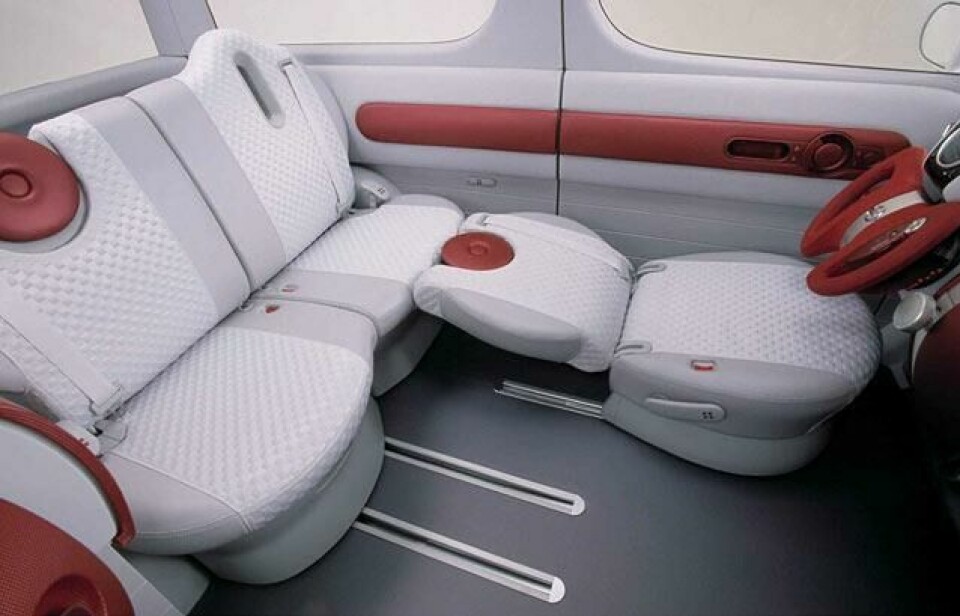
Nissan Chappo concept to be unveiled at the 2001 Geneva Motor Show
The Chappo concept is designed in anticipation of a future generation of young, sophisticated, city-car users who want their car to be more than a means of transport. A generation for which the car has also become a social space for people to gather: their mobile space.


Feb 25, 2001 - According to Nissan, the Chappo concept isn’t designed from the outside in, but rather from the inside out. So while this asymmetrical, compact, tall-two-box city car has a uniquely innovative exterior shape, what’s far more important is what Nissan’s designers have achieved inside - a new approach to interior space.
The Chappo concept is designed in anticipation of a future generation of young, sophisticated, city-car users who want their car to be more than a means of transport. A generation for which the car has also become a social space for people to gather: their mobile space.
It is a car with the space and equipment to become a ‘living-room on wheels’. A place for one person to relax in calm surroundings, to meet with friends, to work, to enjoy music or videos, maybe to surf the web or to play interactive games.
The design theme of Chappo shows clear signs of Nissan’s Japanese roots, but interpreted in a futuristic way. It reiterates themes of a traditional tearoom and incorporates styling cues inspired by Japan’s typical tatami texture and circular windows.
The direction for the Chappo came from head of design Shiro Nakamura, and was developed at Nissan Technical Centre in Japan. The project typifies a new energy in Nissan’s creative operations. It is a concept which breaks the bounds of convention, yet retains an eye on reality. The Chappo concept is based on the idea of a house over-looking a Zen garden. It is defined by Nissan’s designers as a “room on wheels” and the garden can be anything from an urban cityscape to a beautiful bay.
When Nissan’s designers imagined the Chappo concept they considered the needs of a new, cross-national generation of young people who would normally be in their mid to late twenties, living at home, and enjoying a reasonably high disposable income. They like the functionality and comforts of hi-tech, digital features and make extensive use of these in their busy social lives. “The Nissan Chappo is designed to reflect the fact that across the world, youth demands increasingly personal and diverse solutions to lifestyle and recreational needs,” said Nakamura.
The Chappo offers them the opportunity to move their room, with its comfort and features, wherever they want to go whether that is near a city park, in a garden, by the sea or the river, maybe in the mountains.
“We conceived the unique interior of the Nissan Chappo not just for driving, but as a social space where young people will want to meet and relax. The dual-entry door opens both ways to allow easy ingress and egress for all possible configurations of our versatile interior. The ingenious L-shape seating creates a futuristic living room on wheels.” - Kaoru Satou, Chief Designer, Interior, Chappo concept.
The basic shape of the Chappo is that of a tall but compact three-door city car, but the tall body gives far more headroom and the interior layout gives more space, with incredibly high flexibility.
“I have used strong but simple planes combined with subtle angles to give the YYC an almost two dimensional appearance. We opted for an asymmetric exterior design to reflect and enhance the very special interior layout.” - Taro Ueda, Chief Designer, Exterior, Chappo concept.
The Chappo reflects Nissan’s new direction of contrasts supported by heritage. Like the acclaimed Primera Concept, proposed to the public at the Paris Motor Show last October, it combines elements of warm and cold, man and machine, personality and technology - looking to the future while recharging the positive elements of Nissan’s rich heritage.
Beyond being a comfortable and stylish place to meet, and from where to enjoy the view, the Chappo offers many technical and practical features. There are two information screens, a 7-inch monitor which pops up from the centre console, and a 15-inch monitor which folds down from the front passenger area ceiling. The 7-inch monitor is user-information orientated, uses a combination of steering wheel thumb control or touch-screen operation, and is GPS-linked for full interactivity. Its functions include satellite navigation, air-conditioning and music-system controls, and practical information.
The 15-inch screen, and its laptop type keyboard, offer a huge range of further options - in fact virtually as much as any home or office based rival. Those can include television, DVD movies, games, internet access, out-of-office working and link-up options.



